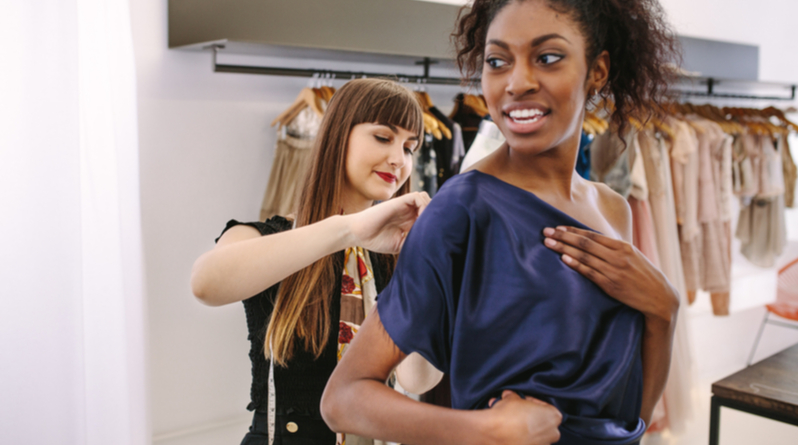What is Fashion Styling?
A fashion Stylist’s role is to select clothing and accessories for events such as appearances made by public figures, music videos, advertising campaigns, etc. Fashion stylists may also work in retail stores or for specific clothing lines as personal shoppers to high-end customers.
Fashion Stylists will have clients who range from actors and politicians to everyday clients who want to improve their wardrobe and update their style.
What courses are available?
Universities and colleges in Ireland are offering courses in the following subject areas:
- Fashion Stylist Course – An introductory course into Fashion Styling.
- Fashion Stylist and Image Consultant – The study of fashion and the design process, elements of style, and trends.
- Fashion Industry Practice Year 1 – The study of garment construction, design, fashion history, and the understanding of range development.
- Fashion Industry Practice Advanced – The study of the practical and business skills needed in the fashion industry. Trend forecasting and the study of contemporary and historical fashion.
- Fashion Design Course – The study of the exciting and glamorous career path of Fashion Design.
- Fashion Design Advanced – The study of theme and concept development of a fashion collection.
Studying Fashion Styling in college
Courses will be delivered through lectures, assignments, tutorials, and taught modules. Assessments will take place continuously with written examinations and practical assignments combined to achieve the qualification.
Learners will be expected to develop art and design portfolios of their work as they progress through their studies.
There are full-time courses that run anywhere from 1 year to 5 years depending on the course and modules selected. There are also part-time courses and night courses available so you can be sure to fit in your studies no matter what your schedule is like.
Competition for styling opportunities is fierce so relevant experience is essential. Many employers will require at least one or two years of experience in a retail or studio environment. Experience in styling products, merchandise, and interiors at fashion shoots or personal styling is highly desirable. This experience could be gained during placements and internships or through a part or full-time job.
Career options
After completing a course in Fashion Styling you will be able to make a start in a career in fashion as a fashion stylist, fashion management, fashion retailing or merchandising, or even as a fashion designer depending on your interests and goals.
The fashion field is highly competitive and always changing as styles and trends change over time.
Fashion stylists work in a variety of settings in the fashion industry and other organizations. Some stylists work with fashion magazines, studios, marketing companies, or advertising agencies. Others work in film, television, and the music industry, providing services on- or off-set. When first starting, fashion stylists may work primarily in the office, training under veteran stylists to learn different styling techniques and clothing lines. Once they have some experience, they may travel to photoshoots or events to coordinate clothing with other visuals in the project scene.
Fashion stylists often work with designer samples and may be expected to collaborate with other professionals, such as photographers and makeup artists. Or they may be online independent contractors who help customers select outfits that match their style and budget. Employed stylists usually work office hours but during seasonal peaks to meet deadlines additional hours may be required. Part-time work and freelance work are also possible where hours will be more varied and you will require more flexibility.
You will likely be required to travel to various locations for meetings and photo shoots both locally and potentially internationally as well.
Related jobs include:
- Fashion Stylist
- Personal Stylist
- Personal Shopper
- Fashion PA
- Design & Retail Entrepreneur
- Fashion Buyer
- Fashion Merchandiser
- Visual Merchandiser
- Fashion Retailer
- Fashion Designer
- Garment Technologist
- Textile Designer
- Fashion Illustrator
- Pattern cutter
- Fashion writer
- Graphic Designer
- Fashion blogger/vlogger
- Model
- Fashion marketing and PR
- Trend Forecaster
- Costume Designer
Further study
After completing a course in Fashion Styling you may choose to pursue further study in a related field to further your career and branch out to other roles in the fashion industry. Fields such as Brand Development, Image Consultancy, Trend Forecasting, Writing and Editing will all offer a new perspective in Fashion Styling and allow you to expand your knowledge base.
FAQ
What Makes a Good Fashion Stylist?
A good fashion stylist is familiar with design, fashion trends, and their client’s brand and desired look. They should be great listeners to determine how to give their clients what they need. To be a great fashion stylist, you must know how to communicate quickly and efficiently with photographers and art directors; you are all part of a team, and the project cannot be successful unless everyone on the team has the same vision. Many fashion stylists work with celebrities and public figures, so you must be on top of fashion trends and be comfortable dealing with high-profile figures.
What are the typical responsibilities of a Fashion Stylist?
· Develop strong, up-to-date knowledge of designers, brands, and trends.
· Accurately follow styling guidelines and preferences.
· Provide expert knowledge on products and styling ensembles
· Source and cast models.
· Work collaboratively with models, photographers, studio coordinators, content managers, producers, and creative directors.
· Source and obtain the most appropriate pieces from collections and ranges for the shoot.
· Purchase props for shoots.
· Direct make-up and hair.
· Supervise photo shoots.
· Assist on set during shoots including steaming, pinning, and fitting clothes or products.
· Ensure sets, mannequins, styling props, and shoot areas are well maintained and tidy.
· Ensure sample stock is not mishandled.
Where can I study Fashion Styling?
Explore your options here
Did You Know?
· The T-shirt is one of the most popular items of clothing in the world, and around two billion of them are sold every single year.
· Historically, purple clothes were only worn by magistrates, emperors, and other aristocracies in Rome, Italy.
· In 1907, a woman was arrested on a beach in Boston for wearing a one-piece swimsuit.
· The record for the world’s longest wedding dress is held by a dress that has a 1.85-mile long train.
· High heels are nothing new to the world. In the 18th century, they were fashionable even for children.
· It is thought that the average woman will buy 145 bags during her lifetime.
· The most common materials for manufacturing clothing are linen, cotton, and polyester.
· Technically, items are only “vintage” if they were made more than sixty but less than a hundred years ago. “Retro” on the other hand, doesn’t refer to old items but rather refers to styles that copy vintage items.












Comments